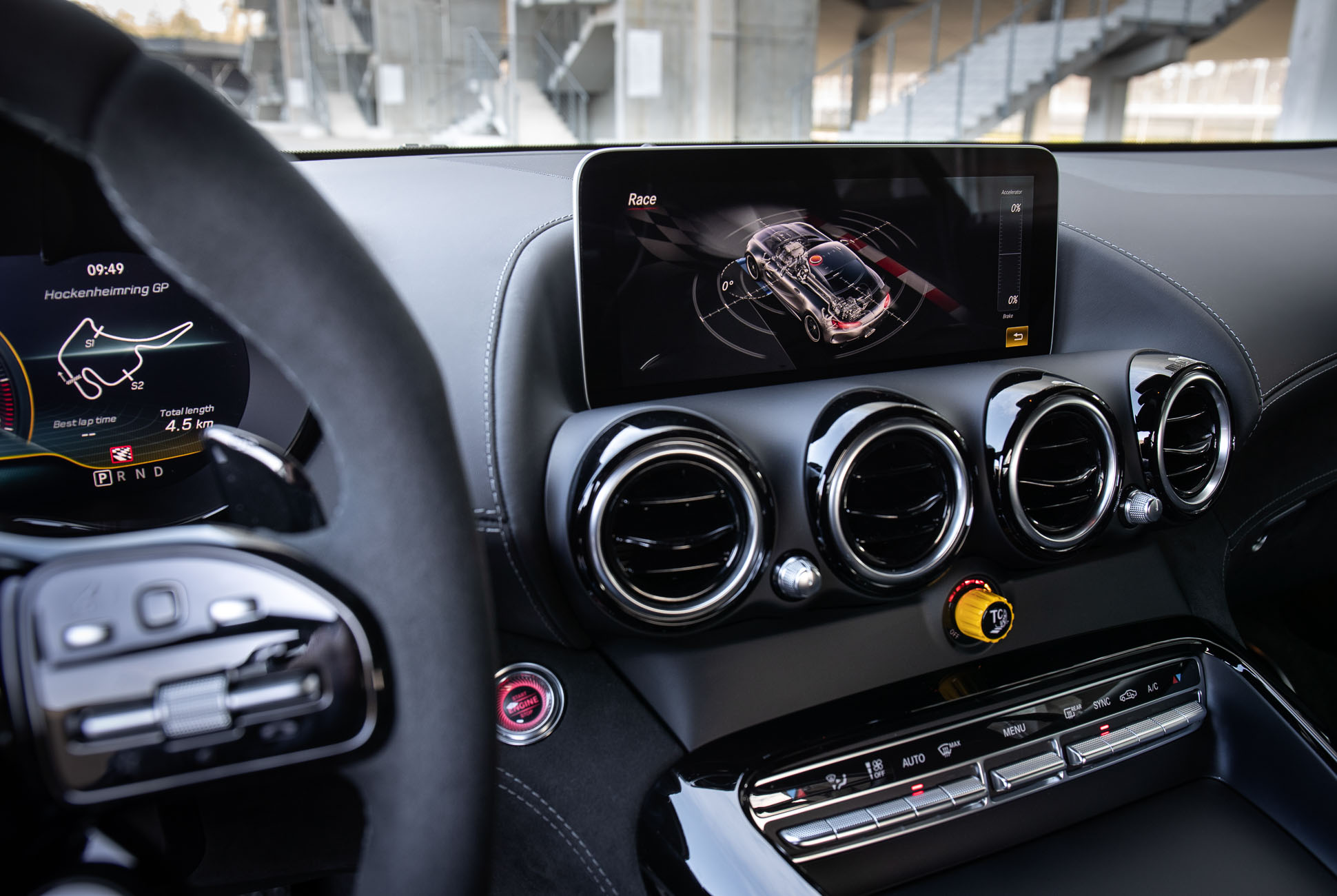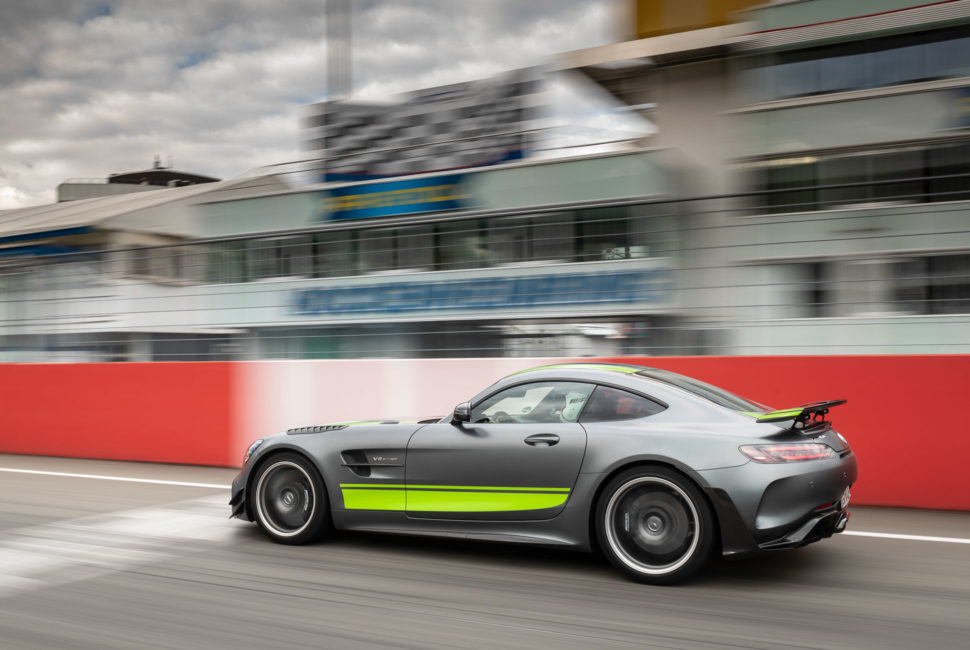The Mercedes-AMG GT R is a 577-horsepower, asphalt-devouring beast that comes standard with a yellow knob that lets you dial in how much you want to drift. It’s practically daring you to dance up to its limits. Oblige, and you’ll find the GT R is pretty much the car version of that one kid in high school who was enviably good at everything he tried.
But the wizards of Affalterbach decided the twin-turbo 4.0-liter V-8 coupe could be faster—imbued with even more agile handling, more stiffness, and more downforce. The result of chasing all that “more” is the 2020 Mercedes-AMG GT R Pro, a high-performance sled that should strike a little fear into the hearts of Porsche 911 GT3 RS drivers as it runs up on them from behind.
When AMG brought your humble author and a group of other journalists to the Hockenheimring Formula 1 circuit—home of the German Grand Prix—to test the GT R Pro, we were ecstatic. Until the 40-degree temperatures and constant rain arrived. Then we were trepidatious. However, the inclement weather actually helped prove that the apex of AMG performance is not just astoundingly capable, but also approachable.
The Good: AMG left the GT R’s prodigious powerplant alone, instead porting over learnings from the AMG GT3 and GT4 race cars to give the GT R Pro superior handling and aerodynamics. (Don’t fret—it’s not lacking in power in the slightest.) A new coil-over suspension offers adjustable compression, via an integrated dial on the damper. Additional ball joints supplant bushings to afford more precise cornering under high loads. Louvres and canards abound, harmoniously working with large diffusers and splitters to increase downforce by 200 pounds at 155 mph over the regular GT R. Plus, the thing just looks menacing, no?
Who It’s For: Anyone who already has several track day toys in the garage. Inherently, the increased stiffness and circuit-focused tweaks make will make this a rather unpleasant grand tourer or daily driver, so it should be reserved for motorsports-minded buyers who will adore the fact that AMG shaved about 20 pounds off the regular GT R by swapping in forged aluminum rims and Recaro buckets.

Watch Out For: U.S. pricing has yet to be announced, but assume the GT R Pro will come in well above $225,000. And there’ll be a limited amount of units allocated for the Americas, so serious buyers will have to act fast. A big bummer comes courtesy of government side-airbag rules, which precludes AMG from offering the U.S. the Track package that includes a rear rollover bar, fire extinguisher, four-point harness, and those lithe Recaro seats.
Alternatives: The most direct competitor is the Porsche 911 GT3 RS, which has two fewer cylinders and is down 77 horsepower, but absolutely shreds on track. The track-focused monster from Flacht clocks in around $210,000, a little under the GT R Pro is likely to. Prospective buyers also may cross-shop the newly-released $242,000 McLaren 600LT, Woking’s mid-mounted V-8, 592-horsepower coupe designed for circuit work. Or a Lamborghini Huracan Evo with all-wheel drive and four-wheel-steering, which gives you 631 horsepower from a naturally-aspirated V-10 for $261,000.
Review: While the photos here depict a dry and welcoming track, trust me: the Hockenheimring was soaked, with more than a few spots of standing water. Our lead instructor, five-time DTM champion driver Bernd Schneider, touched our tester’s Pirelli P Zero street tires (affixed in lieu of the standard Michelin Pilot Cup 2 semi-slicks due to the rain) and shook his head in disappointment.
“They won’t get warm,” he sighed. “Keep your traction control on, please.”

Five minutes later, I was hammering down the Parabolica curve watching my speed crest 145 miles an hour—while panicking, because there was virtually no visibility. Schneider’s tires were creating an enormous cloud of mist, and I peered hard to see where the braking zone began. A faint flicker of red blinked somewhere ahead in the gray fray, so I mashed the brakes and hoped for the best. The prow dove as the roaring V-8 barked and snarled through several downshifts and flung me into the four-point harness as the car shuddered down to a manageable speed for the next turn, a sharp right hairpin.
I waited until just after the apex to jump back on the throttle. The rear end immediately wagged in disapproval. Gingerly, I squeezed the power and tried to catch Schneider, some several hundred yards ahead at this point. Even with careful application of the go pedal, there was wheelspin at around 85 mph as the car shifted from second to third. But the car still hooked up and dug in every time; Schneider’s wet line provided enough grip to allow the car to bite and turn as intended. (Deviation from that path, however, was met with four-wheel slides.) Patience with the throttle—sometimes a five-second delay or longer was required—saw cleaner exits.
The GT R Pro’s driving modes include “Slippery,” though the instructors encouraged the use of “Sport Plus” in a testament to the car’s prowess in these horrible conditions. The introduction of the “AMG Dynamics” integrated dynamic control system to the GT line means that the ECU is monitoring things like yaw rate, wheel speed and spin, and steering input to figure out how much to intervene, if at all. The vehicle tries to anticipate future behavior based on those variables and plan accordingly. Should the GT R Pro sense itself over-rotating, it’ll trim the throttle back and provide some brake-based torque vectoring to right the car’s path. In ESP Sport, the car grants you a longer leash, but also bites back harder, applying as much as double the brake vectoring compared to normal ESP.

Add in the GT3 and GT4-inspired suspension bits (a carbon fiber shear panel, an adjustable carbon fiber front anti-roll bar, the adjustable coil-overs), and you’ve got a planted, predictable ride, even in the wet. All of that combines to inspire confidence. AMG GT3 driver Maro Engel shredded the Nurburgring Nordschleife in 7:04:63 in the GT R Pro—an impressive six seconds faster than the GT R. I couldn’t come close to experiencing that kind of performance in the cold and damp of that German spring morning, but it was clear that it was there for the taking in better weather.
Hopping in Schneider’s right seat for a few ride-along laps was illuminating. When he wanted to drive cleanly, the GT R Pro dutifully complied, agilely rotating around snaking corners without drama or understeer. But when Schneider wanted to attack a corner and flew in super-hot, the car was equally poised, seemingly laughing at the conditions as I laughed at how tidy Schneider was able to keep his driving.
The day at Hockenheim started with six AMG GT R Pros and finished with the same half-dozen cars unscathed—a testament to the car’s exemplary engineering. If it’s this good in the crud, I can’t imagine how much fun it must be in ideal conditions.
Verdict: Whether you’ve spent hundreds of hours turning thousands of laps or it’s your first time, the Mercedes-AMG GT R Pro will have you pushing your limits within minutes. It makes the edge so accessible, you find the car spurs you on to find the limit—yet makes sure you’re not exceeding it.
2020 Mercedes-AMG GT R Pro Specs
Price: Not yet announced
Powertrain: 4.0-liter twin-turbo V-8; seven-speed dual clutch automatic with manual shift mode; rear-wheel drive
Horsepower: 577
Torque: 516 lb-ft
0-60 MPH: 3.5 seconds
Top Speed: 198 mph
Mercedes-AMG hosted us and provided this product for review.

Hot takes and in-depth reviews on noteworthy, relevant and interesting products. Read the Story

